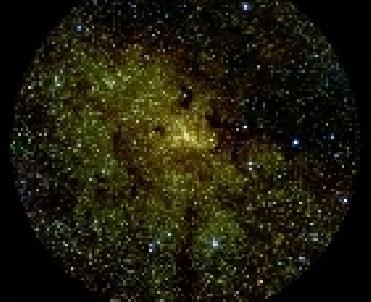
The image of the galactic centre of our Milky Way obtained by the near-infrared camera and spectrometer. Image Credit: University of Florida
FLORIDA (BNS): A team of astronomers at the University of Florida has captured spectacular images of several celestial objects by using an advanced camera/spectrometer designed and built by the University and attached to the Gemini South telescope in Chile.
The team, led by astronomy professor Stephen Eikenberry, late last week captured the first images of the cosmos by the using the telescopic instrument.
�
The handful of �first light� images include a yellow and blue orb-like structure that depicts our Milky Way galaxy, home to thousands of black holes � including, at its core, a �supermassive� black hole thought to be as massive as 4 million suns put together, the University said.
�We plan to use this instrument to provide the first accurate tracking of the growth and evolution of this black hole over the last 4 billion years,� Eikenberry said.
The telescopic instrument � Florida Array Multi-object Imaging Grism Spectrometer or FLAMINGOS-2 � fitted in the Gemini South telescope which is one of the largest observatories in the world, has been designed with the involvement of several scientists, engineers and students over a period of seven years.
FLAMINGOS-2 �sees� near-infrared or heat-generated light beyond the range of human vision. It can detect objects invisible to the eye, such as stars obscured by cosmic dust, or objects so far away they have next to no visible light. It can take spectra of up to 80 different objects simultaneously, speeding astronomers� hunt for old galaxies, black holes or newly forming stars and planets, the University said.
Once the instrument is scientifically tested � a process expected to last around six months � astronomers will use it to explore the Universe�s first galaxies, view stars as they are being born, reveal black holes and probe other cosmic phenomena.
�Achieving first light is a great achievement and important milestone,� Nancy Levenson, deputy director of the Gemini Observatory, said.
The 8-meter Gemini South telescope located in the Chilean Andes is one of only about a dozen 8- to 10-meter telescopes worldwide. The Observatory, which operates twin 8-m telescopes located in Chile in Hawaii, is an international collaboration supported in part by the National Science Foundation.
 Previous Article
Previous Article Next Article
Next Article












The Indian Air Force, in its flight trials evaluation report submitted before the Defence Ministry l..
view articleAn insight into the Medium Multi-Role Combat Aircraft competition...
view articleSky enthusiasts can now spot the International Space Station (ISS) commanded by Indian-American astr..
view article